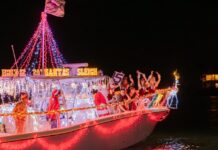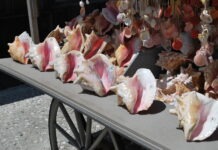10:22 a.m. and the year was still pure. I had not seen a bird.
I was in the living room, staring at my laptop, trying not to look at the bits of blue sky out the window, because if I did a turkey vulture might fly through it, and then the first bird of the year would be a turkey vulture – a bird that eats rotting dead things for a living and whose main form of self-defense is projectile vomiting. Not a good omen or start.
There was a chance, if I stared into the blue sky, I might see a short-tailed hawk, which would be a great omen. But there are, like, five short-tailed hawks flying around Key West this time of year and about 1,000 turkey vultures, so the odds were not in my favor.
I’m not big on superstition, but perhaps because 2020 was so crappy for so many, I wanted my first bird of the year to be a good one. I wanted a sign that 2020 was going to start tracking in a different direction, if only a few degrees.
There had been an American kestrel klee klee-ing around the neighborhood since November, and you can’t go wrong with the smallest falcon in North America. She liked to perch hunt from the telephone pole near the baseball field, which I could see from the backyard. But the small mob of Eurasian starlings that roam the neighborhood also like to hang out there, and sure, Mozart may have taught a starling to sing “Twinkle Twinkle Little Star,” but they’re still an invasive exotic species and an agricultural pest — not where I wanted to start the year.
Leaving the house might bring a good bird. There’s a trio of common ground-doves that like to peck around in the street, just below the front steps, and I still hold an irrational and unsubstantiated suspicion that common ground-doves are actually adorable automatons, like something from “Blade Runner,” so that would be a nice start. But more likely I’d catch sight of the Eurasian collared doves (yawn) or the mourning doves (stifled yawn) that spend hours every day on the wires over the neighbor’s place. And even if I managed to get into a car or onto a bike without seeing such things, there was no way to get to Edward B. Knight (White Street) Pier or Fort Zach or Indigenous Park without seeing something, well, boring.
A post on the Florida Birding and Rarities Facebook page finally got me to move. A guy named Matthew Jolley had reported an American flamingo on a flat off Sammy’s Creek Park on Sugarloaf that morning.
I texted Amanda Chestnutt, one of the artists-in-residence at The Studios of Key West this month, and asked if she wanted to go look for a flamingo. She gave the only sane response a person of quality can give to that question: Sure.
I picked her up, and we were on Palm Avenue, talking about photography, New Year’s Eve misbehaviors and stuff, when I looked up onto the wire and saw a northern mockingbird and, probably a bit too loudly, yelled, “Dammit!”
I mostly know Amanda from online, so I spent a while trying to reassure her I wasn’t, in fact, a crazy person prone to excessive sudden outbursts, and explaining about wanting the first bird of the year be a good bird, and how a northern mockingbird wasn’t a bad bird – they’re some of the most gifted mimics in the natural world – but how they were so common it was harder to not see them than to see them, so it was all a bit of a disappointment.
When we got to Sugarloaf, we went straight to the top of Sammy’s Creek Bridge. I scanned with binoculars. Amanda looked around and snapped a few pictures. It’s one of the more beautiful spots in the Keys – minimal traffic, with mangroves and a deepwater creek to the north, and open water all the way out to the Alligator Reef Light and beyond to the south. But there were no pink birds in all that expanse.
We went down into the park and walked to the rip-rapped edge of the water. I scanned some more, maybe a little impatient for some kind of high-quality harbinger.
“Well, no pink things here,” I said.
“Isn’t that a pink thing?” Amanda said, pointing.
I lifted my binoculars and there it was, very far out, walking slowly, belly-deep in the windblown, milky green water.
We set up the scope and took turns looking. We even showed this nice English couple who happened to be there.
Wild flamingos were thought to be wiped out at the beginning of the 20th century by the plume hunters. They were hardly seen in Florida for close to a century, despite their omnipresence in tourist kitsch and on lottery tickets. They’re not common yet, but they’ve been seen more and more in recent years. There were six seen on Big Torch this summer. And now there was this very real one to start off the new year – pink, 4 feet tall, sticking its head underwater for a long time to feed, then lifting it up to breathe and look around.
That had to be a good sign.



























